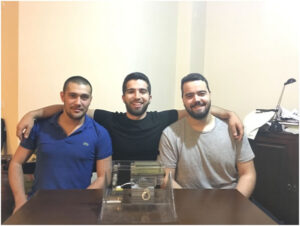Egemen KÜÇÜKGÜL
Efe AYTAÇLAR

In this project, we designed a vibration table and analysed its kinematics. Vibration table is a mechanism that generates vibration for at least two directions. The motion is provided by an engine and through a shaft that transfers rotational motion to linear motion. There exist many kinds of vibration tables for different purposes but they can mainly be categorized into two different subjects, which are industrial and concrete-constriction purposes. The main reasons to be utilized by vibration tables are putting materials into smaller containers, shipping materials with less air, performing fatigue tests, removing air from mixtures, eliminating hand finishing works, improving product quality and reducing defect by less cost. In this project, since we produce a prototype for a vibration table, we have utilized an engine that generates low revolution and torque compared to industrial purposes; therefore, the linear motions in the project are limited. In this project, we give a brief explanation about the design and production steps of the project and then discussed about our kinematics analysis obtained by utilizing Ansys, Matlab, and Maxtraq.
We designed parts of our project in Siemens NX software. First we determined the dimensions of the parts and their magnitudes. Then we designed the parts and finalized the appearance. After the designing step, we thought about the materials we should use. We decided in Plexiglas material. It is easy to produce in laser cutting machine and it is not so heavy that our motor can lift the system. However Plexiglas cutting machine in our school could only cut 10 mm at most. So we sliced the parts that originally should be thicker then 10 mm and made them ready to produce. One of our main parts had to sliced in 10 different plates. Even though we know that suchassemble can cause defects, it was a risk that we should take. We used Solidworks software to design gears that should transfer the motion from the engine to the shaft. We printed our parts and started to assemble them. We used Plexiglas glue for the sliced parts. Since the torque calculations related to the engine were not ready until we bought the engine, we did not printed any parts to put the engine on. Even though in our calculations a 12V 500rpm engine seemed to work, it did not. The engine was not capable of giving motion to our system. Our guess is that the friction forces were much more than we had assumed. We wrapped the pins with Teflon tape and used industrial machine oil at the slider block to reduce the friction forces. We bought a new engine with features of 12V and 200rpm. We used a 220V AC to 12V DC power supply to provide the electrical energy that our system needed. The friction in our system caused a massive vibration so the gears were stacking at some point in every try. We excluded the gears and attached the engine directly to the shaft. The shaft’s cross section is a square of 8 mm and the engine shaft’s cross section is a 6 mm circle. So a hole in the shaft that our engine would fit had to have a diameter of 6 mm. This drilling process caused our shaft to crack many times.Our entire system is based on the 8mm square shaft so we did not have the opportunity to make it thicker. With the trial and error method, we accomplished to make an even hole and finished our project’s production process.